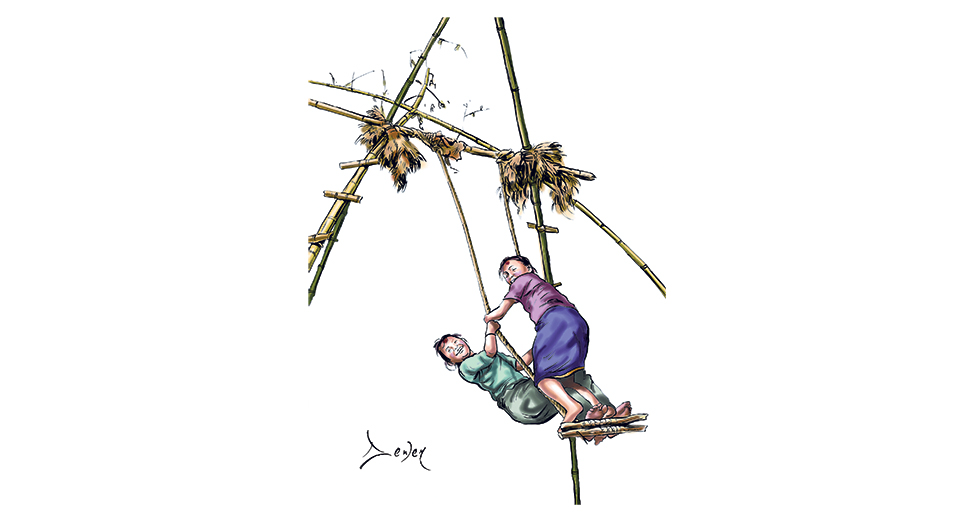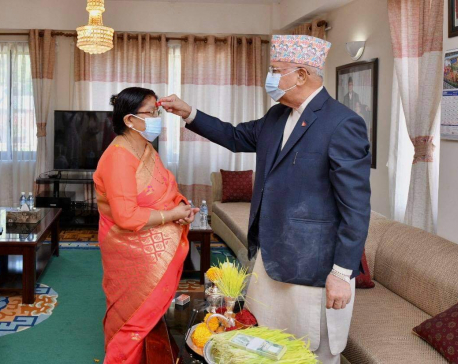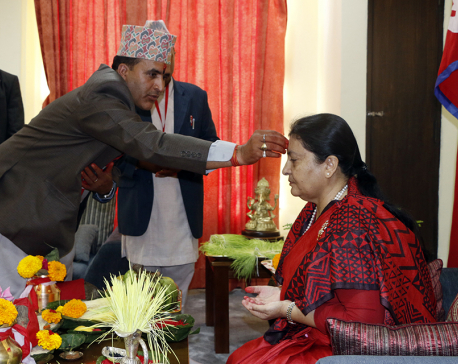
OR
Things you probably didn’t know about Dashain
Published On: October 23, 2020 12:15 PM NPT By: SITU MANANDHAR

Most of us, all over Nepal, celebrate Dashain but we aren’t familiar with the many concepts and stories of this main festival of Hindus. Like with everything else, there are many myths and facts associated with Dashain that can help you see the festival in a new light. Also, the information can make for good conversation starters.
The tika mantra is different for men and women
Traditionally, a mantra would be chanted by the elders of the family (and some still do) while putting tika on their relatives. This mantra was a way of bestowing blessings. The Dashain tika mantra for women is mainly a praise of the different aspects of feminine strength, as depicted by the nine manifestations of Durga. The mantra for men, on the other hand, blessed the receiver with nine heroic qualities according to the Hindu culture, including victory, strength, honesty, pride, virtue, wealth, and a luxurious life. According to the Hindu mythology, gods and goddesses are considered equally powerful. It’s actually the social conditioning, over the years, that has led us to believe otherwise. The Dashain mantras actually promote gender equality as they contain ideas of men and women being equal, in all aspects.
Kumari and Ganesha puja are carried out during Dashain
In the Newar culture, young kids of the family are worshipped as deities because Newars believe they are the epitome of holiness and purity and so god resides within them, especially during the Navaratri. The Kumari puja applies to young girls who haven’t done undergone the traditional Bel Bibaha (marriage to the wood apple) and the ritual of gufa (marrying the sun). Likewise, young boys who haven’t undergone the ritual of Bratabandha are worshipped as manifestations of Lord Ganesha. During the Kumari and Ganesha puja, elders put tika and offer flowers to the children who are being worshipped. Then, as a sign of respect, children touch the feet of the elders and bless them with wishes of good health and a long life. The children, in turn, are given money and gifts.
In the past, Dashain used to be celebrated four times a year
In the past when people worshipped nature, Dashain used to be celebrated four times a year – in autumn, winter, spring, and summer. But overtime, people couldn’t afford to celebrate this grand festival multiple times a year – either because they were too busy or their finances didn’t allow for it. The reason why Sharadiya Dashain (Dashain of autumn season) became popular was because farmers – that made for a majority of the Nepali population back then – waited for the harvest during this time and even the water level in the rivers was low. This made it the perfect time for them to visit their relatives and family members who lived far away – without putting their work on hold or risking their lives. The Dashain of the winter (Hemantik Dashain) and summer (Grishma Dashain) aren’t celebrated anymore whereas the one celebrated in the spring season (Basantik Dashain) is what we now know as Chaite Dashain.
Dashain was moved from Chaitra to Asoj
The Dashain festival was originally celebrated during Chaitra. However, it was shifted to Asoj because the hot weather of Chaitra meant food couldn’t be stored for long. The food that was prepared for grand feasts of Dashain would quickly go bad in the warm weather. So people suffered from all sorts of digestive problems and other illnesses due to contaminated food. This dampened the spirit of celebration as a huge part of Dashain was about feasting. People then came up with the idea to shift it to Asoj when the weather is relatively milder, meaning food would stay fresh for a longer period.
Unmarried women aren’t allowed to see jamara
We all know that jamara is planted during Ghatasthapana. This can be done either by the man or woman in the family. However from the eighth day of Dashain (Asthami) till the tenth day (Bijaya Dashami), unmarried women aren’t allowed to visit the Dashain Ghar (the room where the jamara has been placed). Apparently this is because during Asthami, devotees sacrifice animals to please Kali, Hindu goddess of death, time, and doomsday. The weapons used for the sacrifice such as the Khukuri are cleaned, decorated and used inside the Dashain Ghar. To prevent women – unmarried women to be specific – from seeing blood splatters and horrific sights of death, they are forbidden to enter the Dashain Ghar until the place is cleaned out for Dashami’s tika.
Phulpati also stands for the unification of Nepal
We know Phulpati is the seventh day of Dashain but not many of us know that it’s connected to the unification of Nepal. On Phulpati, Navapatriva (a combination of nine holy plants meant to represent nine Hindu deities) is brought from Gorkha to Dhading. As per our tradition, the one carrying it has to swim across the Budi Gandaki river. The Phulpati is brought to Kathmandu and honored with a 21-gun salute by the Nepal Army. A special parade is also carried out to signify the official arrival of Phulpati. The process of bringing Phulpati from Gorkha to Kathmandu is symbolic of the fact that Nepal is now unified and that the main cities are now equally blessed by goddess Durga.
You May Like This

PM Oli offers Dashain 'tika' and 'jamara' to spouse Radhika Shakya
KATHMANDU, Oct 26: Prime Minister KP Sharma Oli offered 'tika' and 'jamara' to his spouse Radhika Shakya on the occasion... Read More...

Dignitaries receive Dashain tika and jamara (Photo Feature)
KATHMANDU, Sept 30 :President Bidya Devi Bhandari received Tika and Jamara at Rastrapati Bhawan, Shital Niwas from main priest Devraj... Read More...

PM Oli receives Dashain tika
KATHMANDU, Oct 19 : Prime Minister KP Sharma Oli received tika, jamara and tilak from his father Mohan Prasad Oli... Read More...



Leave A Comment